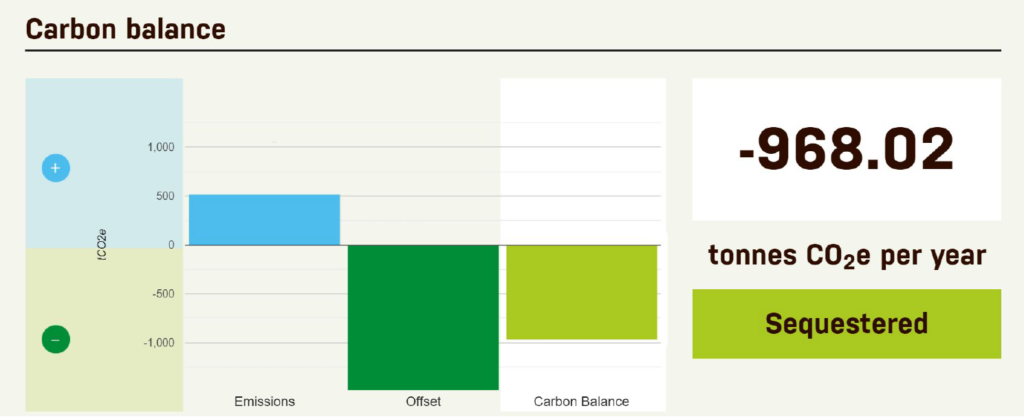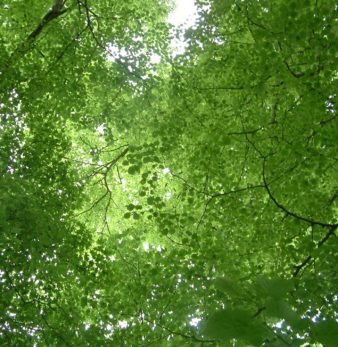Earth Trust Farm – a journey to net zero
By Paul Hill, Head of Land Management, Earth Trust, September 2022
Earth Trust’s new strategy sets out our ambition to be a net zero organisation and to be well on the way to delivering this by 2027. In order to develop our action plan, we are carefully monitoring our carbon impact, creating a baseline from which to improve. The first part of this journey has focused on a carbon audit of the farm.
The audit, funded by the North Wessex Downs AONB Farming in Protected Landscapes programme and conducted by Farm Carbon Toolkit, reveals that Earth Trust Farm operations are overall carbon negative.
At Earth Trust, our role as farmers and producers of food is a critical part of our identity and the green spaces we care for. We have 500 hectares of mixed farmland, demonstrating the links between environment, wildlife, landscape and growing food. Our aim is to farm in a climate-friendly way, working with the environment to enhance a biodiversity partnership that assists us in minimising the farm’s carbon emissions and maximising its carbon sequestration, whilst producing quality food.
Why did we do the carbon audit?
While carbon emissions are inevitable in any production process, the natural assets on farmland (soils, habitats, woodland and hedgerows) have the potential to sequester (capture and store) carbon if managed correctly. As land managers, we can make a difference in supporting carbon sequestration through our conservation and farming activities, as well as reducing our energy usage.
Analysing our farm’s carbon footprint gives us a baseline figure of where we are now. It also enables us to identify practical and scientifically robust actions to reduce our impact on climate change and reach our goal of operating at net zero.
The calculations for the audit are made on a whole farm basis, giving a total carbon balance that includes the greenhouse gas emissions from our farming operations, as well as carbon sequestration in soils and biomass. All inputs to the farm are included, including fuel, electricity, water, fertilisers and materials used throughout the year. Emissions associated with producing these inputs are also included.
What have we learnt?
The results are in and the audit revealed that our farm operations are already better than carbon neutral. We’re actually carbon negative (which is positive!) – sequestering more carbon than we’re emitting.

The total Carbon Balance for the farm works out at -1.95 tonnes of carbon per hectare of land, and -1.1956 tonnes of carbon per tonne of product. These figures are impressive for a farm of our size, but the offsetting figure is so high because almost 1/3 of our farm is comprised of woodland.

A typical tree can absorb 21kg of carbon dioxide (CO2) every year
As trees grow they absorb and lock in carbon which gets stored, not only in the tree itself, but also in its roots and the surrounding soil. We already knew that trees were incredible, but our new learning is that hedges, too, are incredible carbon sponges. New scientific research has discovered that 100m of hedgerow can sequester up to 450kg of CO2e!
This makes tree and hedge planting one of the most powerful tools we have to combat climate change.
How did we manage this?
- Caring for our soil and improving its biological function through a carefully considered land management schedule
- Reducing our energy usage with manual labour (huge thanks to our land management volunteers!) instead of powered tools or machinery. Painstakingly hand-pulling thistles and other weeds means that we can avoid using harmful chemical pesticides
 Traditional hedgelaying (again, thanks to our dedicated volunteers!) and precision mechanical cutting is helping us to carefully manage our hedgerows to allow the accumulation of biomass (which is storing carbon) within the hedge
Traditional hedgelaying (again, thanks to our dedicated volunteers!) and precision mechanical cutting is helping us to carefully manage our hedgerows to allow the accumulation of biomass (which is storing carbon) within the hedge- Utilising precise cereal crop varieties which have disease resistance allows us to reduce our chemical usage (reducing our carbon footprint and saving money!)
- Recycling our plastic farm waste materials with Solway Recycling
- Planting trees, hedges and hedgerow trees
While we are extremely pleased with our carbon negative result, we are also tremendously excited and optimistic about how much more we can accomplish.
Paul Hill, Head of Environmental Land Management at Earth Trust, tells us: “This is such a fantastic baseline for us to move on from. However, we are not complacent and know that we still have much room for improvement. This audit shows exactly where we currently stand with regards our carbon emissions, as well as giving us the direction on the precise things we need to focus on in order to drive our carbon footprint down even further.”
What next?
Learning together is an important principle at Earth Trust. We frequently benchmark and share our learnings with the wider farming community and will continue to seek opportunities to connect with organisations further afield.
This report has highlighted the important contribution played by land management, nurturing and caring for our soil health, as well as the major role that trees and hedges play in storing up carbon.
We have also been able to identify key mitigation strategies that we need to implement on the farm to reduce emissions and improve sequestration opportunities for the benefit of the business as well as the surrounding environment, such as where we can make better use of renewable energy sources and farming inputs.
We will continue to plant many more trees and have plans underway for adding herb and legume lays to our arable fields, which in turn will improve the soil health and then increase carbon sequestration.
This is just the beginning of our farm’s carbon journey – itself part of a bigger journey for Earth Trust and all of our operations. We will be regularly monitoring and updating our carbon emissions calculations as and when we implement different land management strategies, and look forward to extending our learning with data on how our activities are directly impacting the environment around us.